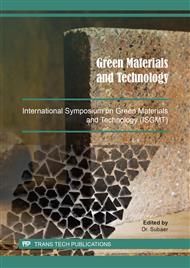[1]
Yulianto, A., Bijaksana, S., Loeksmanto, W., Sekaran, J. R., and Pati, G. (2003), Comparative study on magnetic characterization of iron sand from several locations in Central Java,. Indonesian Journal of Physic, 14, 63-66.
Google Scholar
[2]
Findorak, R., Froehlichova, M., and Legemza, J. (2014), Potential of ilmenite sand application in the iron ore materials agglomeration,. Metalurgija, 53, 9-12.
Google Scholar
[3]
Nugraha, P. A., Sari, S. P., Hidayati, W. N., Dewi, C. R., and Kusuma, D. Y. (2016), The Origin and Composition of Iron Sand Deposit in the Southern Coast of Yogyakarta,. The 2016 Conference on Fundamental and Applied Science for Advanced Technology (ConFAST 2016) AIP Conference Proceedings, 1746, (020028). New York: AIP Publishing.
DOI: 10.1063/1.4953953
Google Scholar
[4]
Bassez, M. P. (2017). Ferromagnesian silicate and ferrosulfide rocks as a source of magnetite and hydrogen,. Procedia Earth Planetary Science, 17, 492-495.
DOI: 10.1016/j.proeps.2016.12.124
Google Scholar
[5]
Sunaryono, Taufiq, A., Mashuri, Pratapa, S., Zainuri, M., Triwikantoro, and Darminto. (2015). Various magnetic properties of magnetite nanoparticles synthesized from iron sands by co-precipitation method at room temperature,. Materials Science Forum, 827, 229-234.
DOI: 10.4028/www.scientific.net/msf.827.229
Google Scholar
[6]
Setiadi, E. A., Sebayang, P., Ginting, M., Sari, A. Y., Kurniawan, C., Saragih, C. S., and Simamora, P. (2016). The synthesization of Fe3O4 magnetic nanoparticles based on the natural iron sand by co-precipitation method for the used of the adsorption of Cu and Pb ions,. Journal of Physics: Conference Series, 776, 012020.
DOI: 10.1088/1742-6596/776/1/012020
Google Scholar
[7]
Ataeefard, M., Ghasemi, E., and Ebadi, M. (2014). Effect of micro and nanomagnetite on printing toner properties,. The Scientific World Journal, 2014, 706367.
DOI: 10.1155/2014/706367
Google Scholar
[8]
Mufti, N., Atma, T., Fuad, and A., Sutadji, E. (2014). Synthesis and characterization of black, red, and yellow nanoparticles pigments from the iron sand,. The 3rd International Conference on Theoretical and Applied Physics 2013 (ICTAP 2013) AIP Conference Proceedings, 1617, (165-169). New York: AIP Publishing.
DOI: 10.1063/1.4897129
Google Scholar
[9]
Bijaksana, S., Huliselan, E., Safiuddin, L.O., Fitriani, D., Tamuntuan, G., Agustine, E. (2013). Rock magnetic methods in soil and environmental studies: fundamentals and case studies,. Procedia Earth and Planetary Science, 6, 8-13.
DOI: 10.1016/j.proeps.2013.01.001
Google Scholar
[10]
Kanu, M. O., Meludu, O. C., and Oniku, S. A. (2014). Comparative study of top soil magnetic susceptibility variation based on some human activities,. Geofisica Internacional, 53 (4), 411-423.
DOI: 10.1016/s0016-7169(14)70075-3
Google Scholar
[11]
Suba, J., dan Styriakova, D. (2015). Iron minerals removal from different quartz sands,. Procedia Earth and Planetary Science 15, 849-854.
DOI: 10.1016/j.proeps.2015.08.136
Google Scholar
[12]
Tamuntuan, G., Bijaksana, S., Gaffar, E., Russell, J., Safiuddin, L.O., Huliselan, E. (2010). The magnetic properties of Indonesian lake sediment: a case study of a tectonic lake in South Sulawesi and maar lakes in East Java,. ITB Journal of Science, 42A (1), 31-48.
DOI: 10.5614/itbj.sci.2010.42.1.4
Google Scholar
[13]
Sudarningsih, S., Bijaksana, S., Ramdani, R., Hafidz, A., Pratama, A., Widodo, W., Iskandar, I., Dahrin, D., Fajar, S.J., Santoso, N.A. (2017). Variations in the concentration of magnetic minerals and heavy metals in suspended sediments from Citarum river and its tributaries, West Java, Indonesia,. Geosciences, 7, 66.
DOI: 10.3390/geosciences7030066
Google Scholar
[14]
Togibasa, O., Bijaksana, S., and Novala, G. C. (2018). Magnetic properties of iron sand from the Tor River Estuary, Sarmi, Papua,. Geosciences, 8, 113.
DOI: 10.3390/geosciences8040113
Google Scholar
[15]
Tiwow, V. A., Arsyad, M., Palloan, P., and Rampe, M. J. (2018). Analysis of the mineral content of iron sand deposit in Bontokanang Village and Tanjung Bayang Beach, South Sulawesi, Indonesia,. Journal of Physics: Conference Series, 997, 012010.
DOI: 10.1088/1742-6596/997/1/012010
Google Scholar
[16]
Fahlepy, M. R., Tiwow, V. A., and Subaer. (2018). Characterization of magnetite (Fe3O4) minerals from the natural iron sand of Bonto Kanang Village Takalar for ink powder (toner) application,. Journal of Physics: Conference Series, 997, 012036.
DOI: 10.1088/1742-6596/997/1/012036
Google Scholar
[17]
Yulianto, A., Sulhadi, A., Ahmad L. I., and Dayati, E. (2013). Synthesis of iron sand into nano Mn-ferrite,. Malaysian Journal of Fundamental and Applied, 9 (4), 211-215.
DOI: 10.11113/mjfas.v9n4.112
Google Scholar
[18]
Rahmawati, R., Melati, A., Taufiq, A., Sunaryono, Diantoro, M., Yuliarto, B., Suyatman, S., Nugraha, N., and Kurniadi, D., (2017). Preparation of MWCNT Fe3O4 nanocomposites from iron sand using sonochemical route,. IOP Conference Series Material Science Engineering, 202, 12013.
DOI: 10.1088/1757-899x/202/1/012013
Google Scholar
[19]
Dearing, J. (1999). Environmental magnetic susceptibility: using the Bartington MS2 system,. British Library Cataloguing in Publication Data.
Google Scholar
[20]
Hunt, C.P., Moskowitz, B.M., Banerjee, S.K. (1995). Magnetic properties of rocks and minerals in rock physics and phase relations: a handbook of physical constants,. American Geophysical Union. 189-204.
DOI: 10.1029/rf003p0189
Google Scholar
[21]
Schon, J. H. (1996). Physical properties of rocks: fundamentals and principles of petrophysics,. Institute of Applied Geophysics Leoben Austria.
Google Scholar


